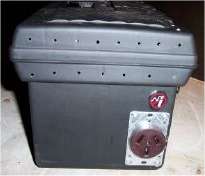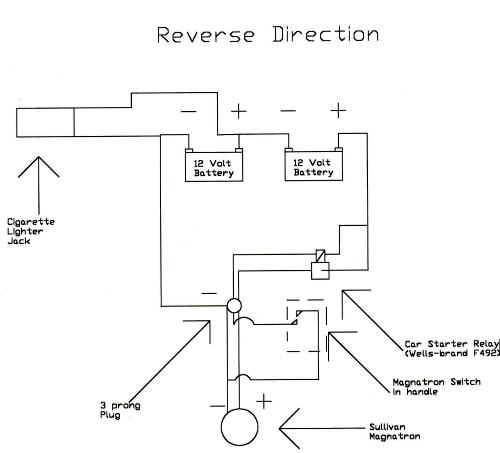
| Gas engines turn big props......Big surprise there. We all have probably been nicked by props on the smaller glow engines and have escaped with, hopefully minor, reminders to pay attention. When I went to the larger engines, such as the ST 3000, I became aware that these 16 to 20" props won't just cut you, they possess the power to remove parts of my body that I have grown very fond of in my xx years. When I was in the ST 3000 phase and less expensive Master Airscrew Props, I went to an oak Chicken Stick. I broke two, and had them ripped out of my hand three times. I decided that there had to be a better way and my trusty 12v Sullivan hand starter was not it! Then I graduated to a pair of ZDZ 80's, with three blade props. (I might add that using a Chicken stick on carbon fiber props is not an option......there's way too much money in those 23" baby props!!!!) Yes, I did start them with the mandatory leather glove. The problem is that the three blade props get to the little finger faster than you can get it out of the way. Curling it ( The finger!) in, helps, but is not an intelligent fix. Sullivan makes a two-handed monster called the Megatron Starter. Off to the local hobby store, hardware store, and auto parts store for finger insurance.
|
|
Problems started here.
With 12 volts it still would not turn the ZDZ 80cc, 10 to 1 compression ratio, and 8.5 horsepower monster, with the pricey Mejzlick props. The supplied switch in the handle of the Sullivan Megatron is not up to the task. Too much amperage for the blade-type contacts in the handle. Using 24 volts worked fine...until I burned out the metal switch in one of the handles, due to current flow. ( So much for reduced amperage at higher voltage!) Not one to be told I can't do this, ( keeping my fingers safe), I let my imagination run wild.
|
Materials
1. Two lawn mower batteries at 285 cold cranking amps. Cost at Auto zone...$22.00 each, plus Environmental deposit. Part number U1-1.
2. One large plastic tool box. (Metal not good idea with this much power inside!) Ace Hardware store Part number "Dura Bull" 20" x10" #2002103.Cost $14.99.
3. One Ford Car starter relay from Auto Zone. Wells product F492. Cost $8.99.
4. Three connector (50 amp )6 foot home cooking-range cord, with male plug. Cost $12.49. Part number at Ace- 31445
5. 50 amp female plug for range cord. Cost $4.99 Ace Part number-36012.
6. One 12v cigarette lighter outlet for 12 volt items such as air compressors for retracts and field chargers. Cost at Auto Zone (Victor brand -V 5410), $2.99.
7. "No smoking" plug for the opening. Cost $0.99. (Politically correct)
8. Six crimp-on connectors for the four gauge wire. Ace cost $1.00 each.
9.Six feet of four gauge wire,( to minimize voltage loss during cranking.) $1.00 per foot. Ace Hardware has, or any good stereo store. |
Assembly
|
Mount the batteries in the tool box and connect in series using the four gauge wiring and crimp-on connectors. It is a good idea to put several holes in the box to vent gases that build up in the charging and discharging cycle.
Also always open the box when using the starter to avoid a fire or explosion due to built up gases. Mount the range female plug outlet and 12 volt cigarette in the side of the box to the front side. Block, using wood blocks, the batteries in place. You do not want them sliding around next to the relays. Connect the 12 volt outlet, from the cigarette lighter outlet, to only one battery. You only want 12 volts. I used four gauge wire inside of the battery box to minimize voltage losses. The ground wire of the second battery goes to one of the large terminals of the Ford car starter relay. The positive lead of the first battery goes to the plug receptacle, outside connection of the plug or wire. Connect a four gauge jumper from the positive of one battery to the negative of the other battery. Instant 24 volts.
Note: Do not make this connection until all other wiring is completed to avoid shorts during assembly.!!! Total 24 volts. The ground of the solenoid goes to the ground of the second battery. Use 12 gauge wire for this connection. Note, this is not the small terminal marked "I", it is the base plate of the relay.Yes, the relay is for 12 volts, but works fine for this purpose. Run another four gauge wire from the relay's other large terminal to the 50 amp plug outside wire connection. Connect the three wires, of the 50 amp range cord, to the starter motor and switch. Securely mount the large range power wire to the screws at the back of the handle on the starter motor. I used a small metal strap to hold the cord to the back of the starter. Do not crush the wires and short them out. The outer wires, of the cord, go to the power wires of the starter. The positive lead from the starter goes to the positive lead of the first battery via the 50 amp plug. The negative lead goes to the remaining large terminal at the
starter relay, via the plug.
The original switch in the handle is to trigger the relay. It is too light to handle the current of big gas engines.I put one lead of the switch to the positive lead from the battery wire, at the starter, and the other to the third wire ( what was once the ground or common wire) of the 50 amp range cord. The third lead (or common wire) goes to the relay trigger terminal small terminal marked "S", back in the box via the plug. Use 12 gauge wire to connect the common wire of the plug to this terminal at the relay. Connect the jumper wire from the two batteries together in the box to complete the power circuit. Insert the drier plug into the female receptacle on the side of the box and you are all set...Power!! ARG-ARRGG!! Press the switch in the handle of the Sullivan starter to test. Unless you hooked up the wires to the motor backwards! It is not advisable to turn the starter free in the air for very long.....It really spins up and could be hard on the armature. I have no idea how fast it turns my engines ( give me a break, my hands are full!), but the prop blast blew all of the debris on my work bench, all over the room while testing it (with no fuel) in those ZDZ monsters!!!!!
Ok, so it now weighs around 18 pounds, but I still have five fingers on each hand to lug it!!! Then I outsmarted myself and got a good deal on another P-38. ( Try negotiating a second 100 plus inch P-38 with the wife!!!!!!! OK, so I married outside my class in life!) You guessed it......It has counter rotating engines!!!!! Now, I had to go back and add another starter relay, wiring,and plug, for the reversed engine!! Each time I must start the reversed Super Tigre 3000 engine on the new P-38, I change the plug to the second range plug, at the box, for the counter-rotating engine.
|


Notice: Please use this information at your own risk.
RCWarbirds.com is not responsible for damage incurred from using this procedure. Always use extreme caution while working with any electrical device.
|
BACK to PROJECTS
|
|
Become an RCWarbrids site supporter by making a donation.
|
$5.00 |
 |
$10.00 |
 |
$15.00 |
 |
$20.00 |
 |
| |
|
|
|
|
